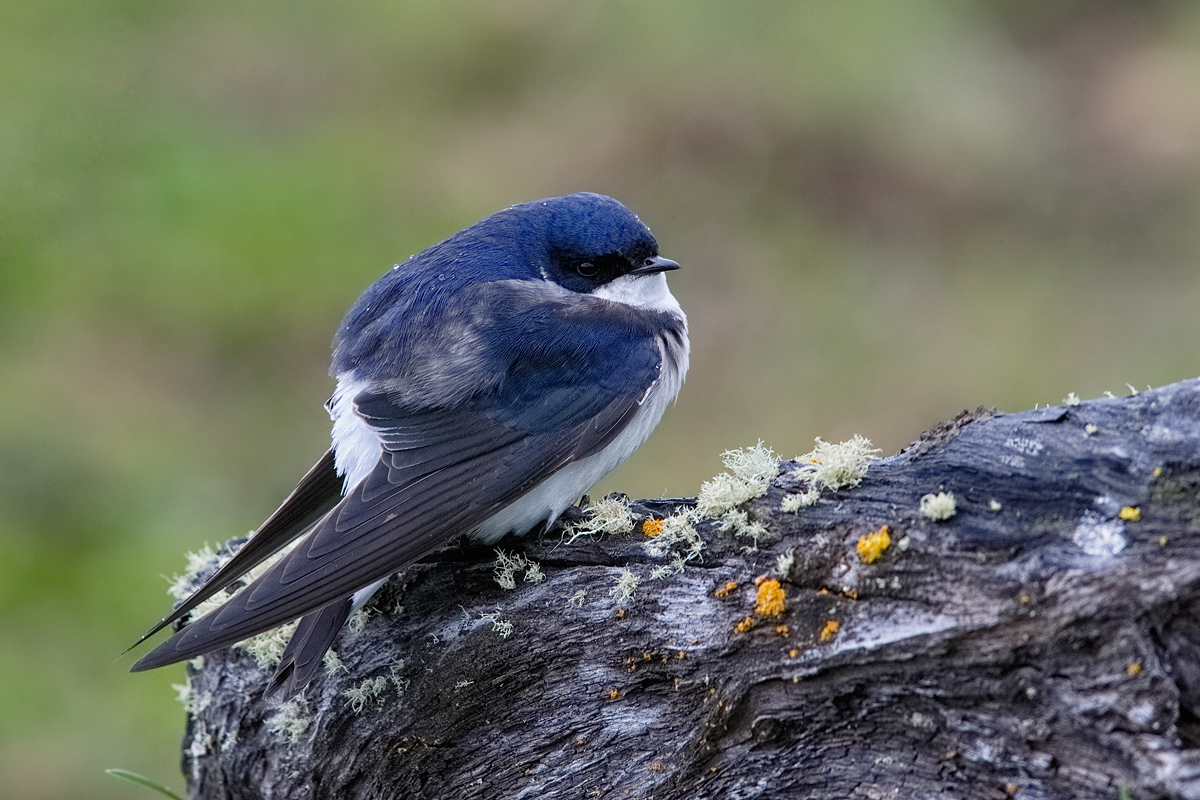
|
|
This Chilean Swallow image was created south of Puerto Natales, Chile with the Gitzo 3532 LS carbon fiber tripod, the Mongoose M3.6 head, the Canon EF 600mm f/4L IS II USM lens, the Canon 2x EF Extender III (Teleconverter), and the Canon EOS-1D X. ISO 3200. Evaluative metering +2/3 stop: 1/125 sec. at f/11 in Manual mode. Central sensor (by necessity) Expand/AI Servo Rear Focus AF on the bird’s eye and re-compose. Click on the image to see a larger version. |
With and Without: Teleconverter Versatility
The image above was created on a wild, wild day along the coast and a bit inland, south of Puerto Natales, Chile. We experienced rain, bright sunshine, wind gusts of up to 55 mph, wind driven icy hail that struck our face like tiny bullets, and even 30 seconds of large snow flakes. We came across some swallows roosting on a barbed wire fence. Surprisingly, many of them were fairly tame. When I saw the single bird perched on a lichen covered log, my eyes lit up.
In order to get the lens on the bird, I positioned the tripod carefully with two legs against the fence in a small creek and one lengthened leg on the grass. But the rig was off balance and the wind was howling so I needed to hold onto the longer leg with my left hand and fire the shutter with my right. Two of twenty images were acceptably sharp. Note the fine high ISO performance of the 1D X.
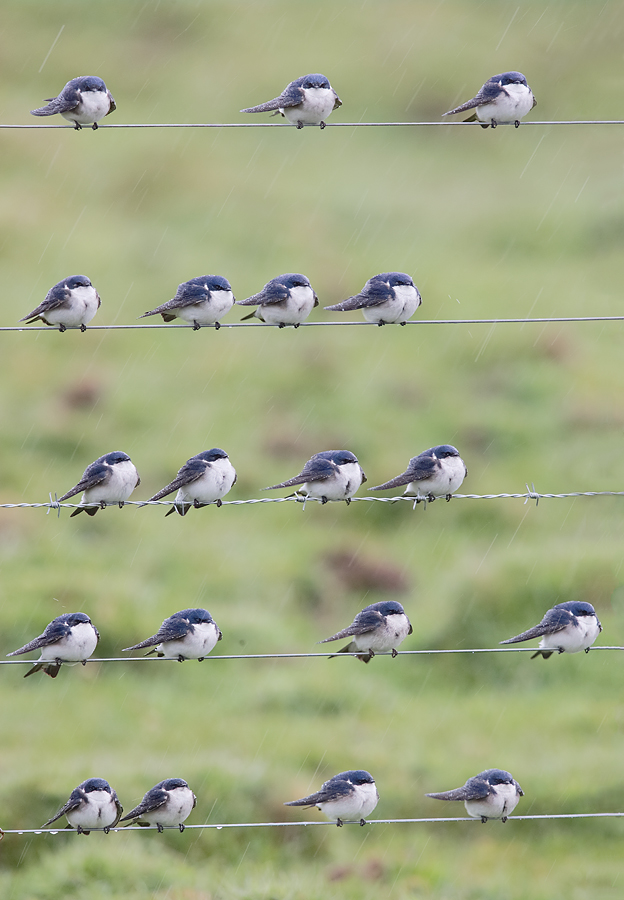
|
|
This image was also created south of Puerto Natales, Chile, this one with the Gitzo 3532 LS carbon fiber tripod, the Mongoose M3.6 head, the Canon EF 600mm f/4L IS II USM lens and the Canon EOS-1D X. ISO 1600. Evaluative metering +2/3 stop: 1/125 sec. at f/6.3 in Manual mode. Central sensor (by necessity) Expand/AI Servo Rear Focus AF on one of the birds middle left and re-compose. Click on the image to see a larger version. |
Going Wide With the 600II
After getting the image of the single bird that I wanted, that is, a bird not on a wire strand, I headed back to the van in the heavy rain. Everyone else has quit. When I saw the lovely array of swallows on the fence I removed the 2X TC, moved back a bit, and began creating images. With the wind pounding and the temperatures dropping still, framing each image was difficult at best. I needed to grab a sliver off the right of a second image in the series in order to create a sort of stitched composite so that there was some room in front of the birds on our right.
The Lesson
Remember that working with the 1.4X and 2X converters (and don’t forget to throw in the 1.7X Nikon TC) can increase the versatility of your kit. Many folks are reluctant or even afraid to add or remove TCs in the field. If you practice turning your camera off before switching out any accessories and then turning it back on (the latter is the hard part for me :)) you minimize problems with sensor dust.
Your Favorite?
Which of the two is your favorite? Please let us know why.
EOS-1D X Autofocus Guide
Until I get around to doing a complete user’s guide for the 1D X my 1D X Autofocus Guide will help you to master and get the most out of my all time favorite professional digital camera body. It includes my customized Case setting for photographing birds in flight and in action.
5D Mark III User’s Guide
EOS-5D Mark III User’s can learn to set up and use their cameras exactly as I do. Includes detailed advice on all menu and custom function items, AF suggestions, and all you need to know about creating great in-camera HDRs and Multiple Exposures.
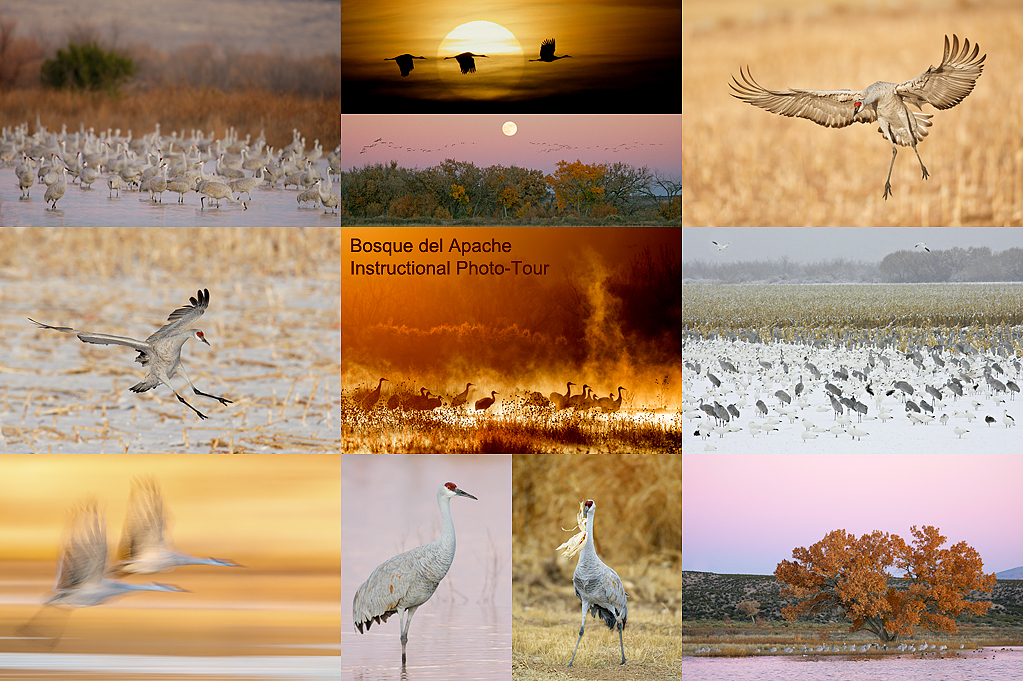
|
|
Bosque Sandhill Crane Composite; click on the image to enjoy a larger version. |
Bosque del Apache 2013 IPT: “The Complete Bosque Experience.” NOV 26-DEC 2, 2013. 7-FULL DAYS: $3399. Co-leader: Denise Ippolito. Introductory Slide program: 6:30 pm on 11/25. Limit: 12/Openings 8.
Please see the info on the short version of this IPT below if you will be spending Thanksgiving with your family.
Tens of thousand of Snow Geese, 10,000 Sandhill Cranes, ducks including point-blank American Wigeon and Wood Duck, amazing sunrises, sunsets, and blast-offs. Live, eat, and breathe photography with one of (if not the) world’s premier photographic educators at one of his very favorite locations on the planet. Top-notch Photoshop instruction. This will make 19 consecutive Novembers at Bosque for me. Nobody knows the place better than I do. Join us to learn to think like a pro, to recognize situations and to anticipate them based on the weather, especially the sky conditions, the light, and the wind direction. Every time we make a move we will let you know why. When you head home applying what you learned will prove to be invaluable. Includes all lunches and the Thanksgiving Buffet at the Crowne Plaza in Albuquerque. I hope that you can join me for what will be an unparalleled learning experience.
There is never a strict itinerary on a Bosque IPT as each day is tailored to the local conditions at the time and the weather. We are totally flexible in order to maximize both the photographic and learning opportunities. There is an introductory slide program on the night before the tour begins. We are up early each day leaving the hotel by 5:30 am to be in position for sunrise. After 18 years we pretty much know where to be when in what sky conditions and what winds. We usually photograph until about 10:30am. Then it is back to Socorro for lunch and then a classroom session with the group most days. We head back to the refuge at about 3:30pm each day and photograph until sunset. Then dinner with the group most nights. We always spend at least one afternoon at the ponds at the Albuquerque Zoo doing Wood Ducks and usually two mornings at New Mexico Tech doing American Wigeons. The rest is Snow Geese and Sandhill Cranes with the emphasis on expanding both your technical skills and your creativity.
A $500 non-refundable deposit is required to hold your slot for this IPT. Your balance, payable only by check, is due now. You will receive an e-mail notifying you of that after you place your deposit. If the trip fills, we will be glad to apply a credit applicable to a future IPT for the full amount less a $100 processing fee. If we do not receive your check for the balance on or before the due date we will try to fill your spot from the waiting list. If your spot is filled, you will lose your deposit. If not, you can secure your spot by paying your balance.
Please print, complete, and sign the form that is linked to here and shoot it to us along with your deposit check (made out to “Arthur Morris.”) You can also leave your deposit with a credit card by calling the office at 863-692-0906. If you register by phone, please print, complete and sign the form as noted above and either mail it to us or e-mail the scan. If you have any questions, please feel free to contact me via e-mail.
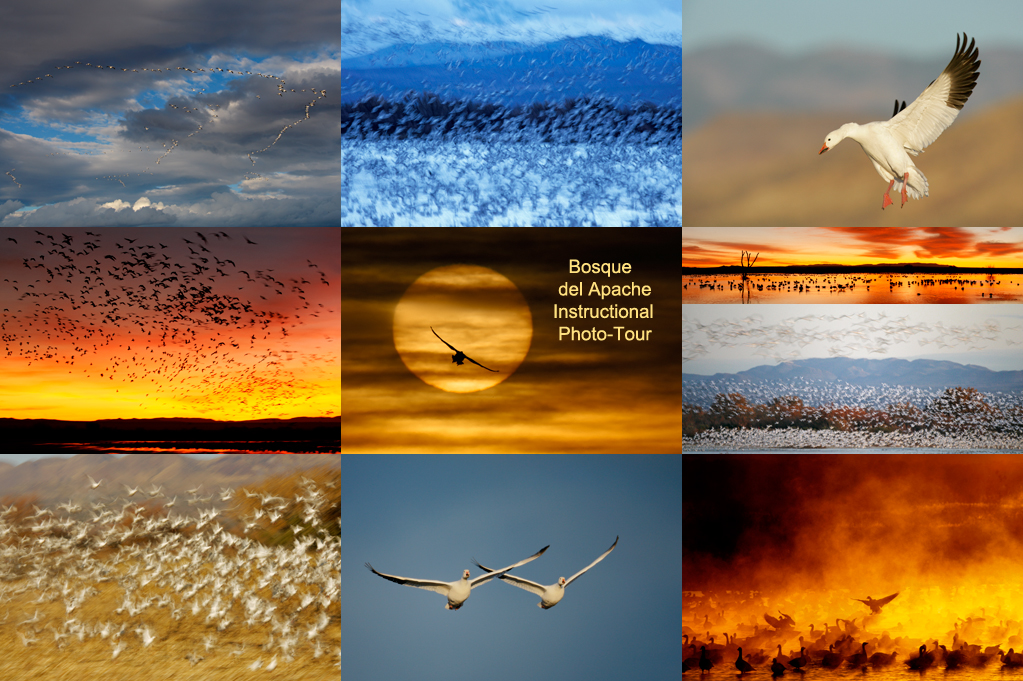
|
|
Bosque Snow Goose Composite; click on the image to enjoy a larger version. |
Bosque del Apache 2013 IPT: “The Short Version.” NOV 30-DEC 2, 2013. 3-FULL DAYS: $1199. Co-leader: Denise Ippolito. Introductory Slide program: 7:30 pm on 11/29. Limit: 12/Openings 4.
Tens of thousand of Snow Geese, 10,000 Sandhill Cranes, amazing sunrises, sunsets, and blast-offs. Top-notch Photoshop instruction. This will make 19 consecutive Novembers at Bosque for artie. Nobody knows the place better than he does. Join us to learn to think like a pro, to recognize situations and to anticipate them based on the weather, especially the sky conditions, the light, and the wind direction. Every time we make a move we will let you know why. When you head home applying what you learned will prove to be invaluable. Includes all lunches. I hope that you can join us for these three great days; they will offer a great learning experience.
There is never a strict itinerary on a Bosque IPT as each day is tailored to the local conditions at the time and the weather. We are totally flexible in order to maximize both the photographic and learning opportunities. There is an introductory slide program on the night before the tour begins. We are up early each day leaving the hotel by 5:30 am to be in position for sunrise. After 18 years we pretty much know where to be when in what sky conditions and what winds. We usually photograph until about 10:30am. Then it is back to Socorro for lunch and then an informal Photoshop/image review session with the group most days. We head back to the refuge at about 3:30pm each day and photograph until sunset. We may spend an afternoon at the ponds at the Albuquerque Zoo doing Wood Ducks and we may spend a late morning at New Mexico Tech doing American Wigeons. The rest is Snow Geese and Sandhill Cranes with the emphasis on expanding both your technical skills and your creativity.
A $500 non-refundable deposit is required to hold your slot for this IPT. Your balance, payable only by check, is due now. You will receive an e-mail notifying you of that after you place your deposit. If the trip fills, we will be glad to apply a credit applicable to a future IPT for the full amount less a $100 processing fee. If we do not receive your check for the balance on or before the due date we will try to fill your spot from the waiting list. If your spot is filled, you will lose your deposit. If not, you can secure your spot by paying your balance.
Please print, complete, and sign the form that is linked to here and shoot it to us along with your deposit check (made out to “Arthur Morris.”) You can also leave your deposit with a credit card by calling the office at 863-692-0906. If you register by phone, please print, complete and sign the form as noted above and either mail it to us or e-mail the scan. If you have any questions, please feel free to contact me via e-mail.
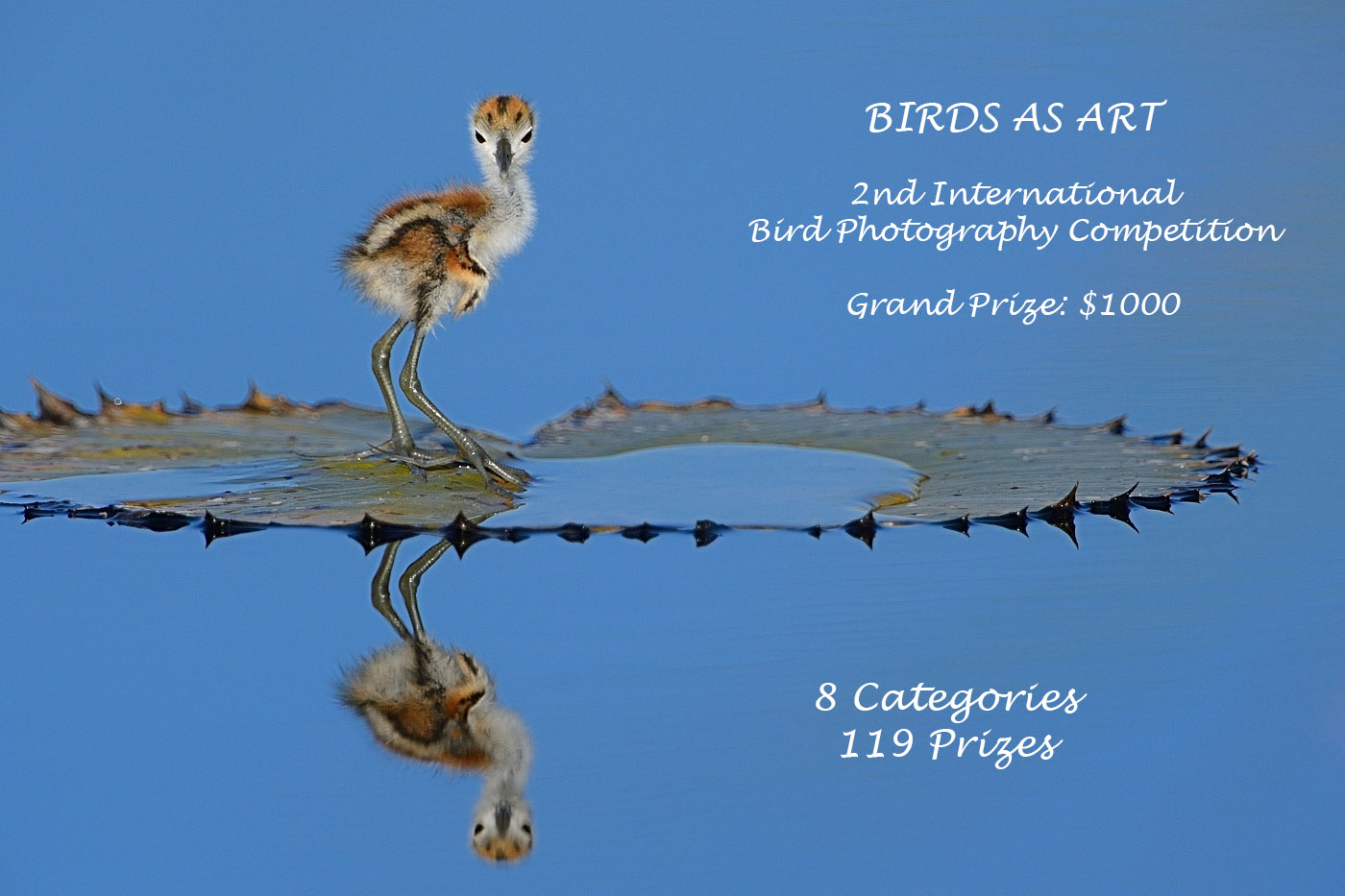
|
BIRDS AS ART 2nd International Bird Photography Competition
Learn more and enter the BIRDS AS ART 2nd International Bird Photography Competition here. Twenty-five great prizes including the $1000 Grand Prize and intense competition. Bring your best.
2014 Tanzania Summer Safari
If you are interested in joining us in Tanzania next summer please shoot me an e-mail and I will be glad to forward you the PDF with dates, itinerary, and price.
Support the BAA Blog. Support the BAA Bulletins: Shop B&H here!
We want and need to keep providing you with the latest free information, photography and Photoshop lessons, and all manner of related information. Show your appreciation by making your purchases immediately after clicking on any of our B&H or Amazon Affiliate links in this blog post. Remember, B&H ain’t just photography!




Amazon
Everyone buys something from Amazon, be it a big lens or deodorant. Support the blog by starting your search by starting your search by clicking on the logo-link below. No purchase is too small to be appreciated; they all add up. Why make it a habit? Because I make it a habit of bringing you new images and information on an almost daily basis.
Typos
In all Bulletins, feel free to e-mail or leave a comment regarding any typos, wrong words, misspellings, omissions, or grammatical errors. Just be right. 🙂
IPT Info
Many of our great trips are filling up. Two great leaders ensure that you will not learn more anywhere about how to make great images. Click here for the schedule and additional info.














Artie, great captures. I would have been scared to change lenses in the conditions you describe. You’re using professional equipment that’s weather sealed once, well, sealed. But during the lens change this is not the case. What tips can you provide us? Steve
The rain was more spitting than drenching so I was not worried about the gear. When changing, adding, or removing TCs, keep you back to the wind 🙂 artie
They are both terrific but I love the image of all the swallows on the wire- great job with that wind!!
Thanks Lady D 🙂
Artie the first picture is the best. The natural look of the wood and the detail of the grain and lichens. The color on the birds wings and color of the wood the blues and grey compliment each other. I think it’s sometimes the small details that add to overall composition. Also the angle of the swallow i think adds to the composition. I learned from you at Chattanooga the angle of the head how it adds some more definition and have been looking at it more in my bird photos thanks Kevin
You are most welcome. I love them both equally :). I was lucky that one of the sharp ones had a decent head angle as the wind was slightly from the bird’s left….
Artie, welcome back if you are, and safe travels if you are not. These images are quite lovely as are Denise’s! Congratulations. I prefer the group on the wires and agree with Steve – it’s a behavior shot that describes the harshness of their environs. cheers and hope to see you around nuevo mejico.. hp
I adore the birds on the wire fence! It really brings a smile to my face and I like that it is a bit different from the usual bird photographs. Thanks for enduring the difficult conditions to get it.
They are both very good images, done in difficult conditions. They are so different it is hard to choose a favorite. They look very much like Tree Swallows.
I prefer the group on the wires. It’s more unusual for bird images and gives more information about the bird behavior. Both images are artistic so no help choosing there.
Both are super. Winner is the first one by a nose…er…a beak! 🙂
Hi, Artie. Those are both wonderful images; so different that it’s hard to choose a favorite, but I’ll choose the second. I like the pattern of the birds, their attitudes, the rain (hail? visible behind them, and that there are so many of them. I have tried to make images of multiple swallows on wires here in the US but obviously need to get much better at it! I’m guessing the weather affected you much as it did those birds.
That was rain, and yes, I was colder than the birds!
The group shot is great, they look like some kind of solitaire game. But I prefer the close-up, the detail & colour is very attractive.